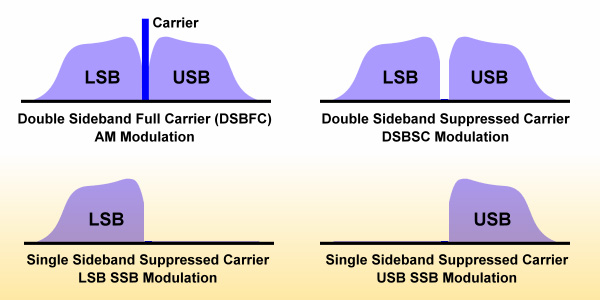
| Single Sideband Modulation Methods for Radio Communication |

Let us return our focus to SSB that is perhaps the single most used radio signal modulation mode used in amateur radio. Almost the entire HF band amateur radio communication is conducted using SSB. It is also used extensively for VHF/UHF terrestrial radio communication and satellite radio after FM. This modulation mode is very robust and highly spectral efficient in nature. 
Typically, on the HF radio bands, most types of communication including SSB radiotelephony, the LSB is generally used on all bands from 160m to 40m while USB is used for 20m to 10m bands. The CW mode QSO, however, is usually conducted on all bands in LSB while working as modulated CW (MCW) through SSB transceivers. There is no hard and fast rule but the above usage pattern is traditionally in vogue. We mentioned earlier that SSB requires relatively more complex circuits in the transceiver to achieve the goal in comparison to AM. However, it is quite worth the effort as it offers substantial benefits. The first advantage ais the narrower band space occupancy by SSB signal which turns out to be half that of AM. Hence, twice the number of independent communication channels may be accommodated in the limited bandwidths available to amateur radio service, especially on the HF bands. Secondly, and more importantly, the radio transmission power efficiency is four times (4x) better for SSB than AM due to the absence of carrier that wastes 50% power as well as another 50% of the balance power due to the removal of the redundant sideband. We had discussed earlier the simple modulation processes that were required to achieve AM. However, the radio signal modulation process required for producing SSB is slightly more elaborate. Traditionally, there are three methods of generating an SSB modulated signal. These methods may be used both for implementing SSB using analog as well as digital processes. They are the Filter Method (First method), Hartley Modulation (Second method), and Weaver Modulation (Third method). There is one thing that is common to all the three above-cited methods for SSB generation. It is the core modulator or demodulator block. Unlike AM, this core block typically has an additional requirement. To start producing SSB, the most important factor is to use a modulator circuit with the inherent capability to suppress the carrier component at its output. Although the SSB generation by retaining only one sideband (LSB or USB) would be done by the any of the three cited methods of SSB generation, the carrier needs to be removed by the core modulator block. We use a circuit configuration called Balanced Modulator. The objective of the balanced modulator is to produce both the sidebands but suppress the carrier. In reality, a balanced modulator that is practically used goes one step further and is called Double Balanced Modulator (DBM). Not only does a DBM suppress the carrier but unlike a simple balanced mixer, it also suppresses the modulating baseband signal and prevents it from appearing at the output. Hence, a DBM can isolate both the input ports (carrier input and baseband input) of the modulator from the output. There are several ways of physically realizing a DBM as electronic circuits. Passive DBM like the Ring Modulator configuration or active DBM like the Analog Multiplier Gilbert Cell configuration is quite common. Radio amateur equipment has consistently used popular integrated circuit (IC) implementation of Gilbert Cell type DMB. A very popular IC has been the MC1496. Switching type circuit configurations like Sampling Modulator or Quadrature Sampling Modulator are also good options that are often used in modern SDR transceiver designs. There are other ways of achieving the objective too. The important attribute of a DBM irrespective of how it might be implemented is that it contains only the two sidebands (LSB and USB) components at its output while having removed the carrier and baseband components. |
| Leave Message |
|
Message Has Been Sent Successfully
|

